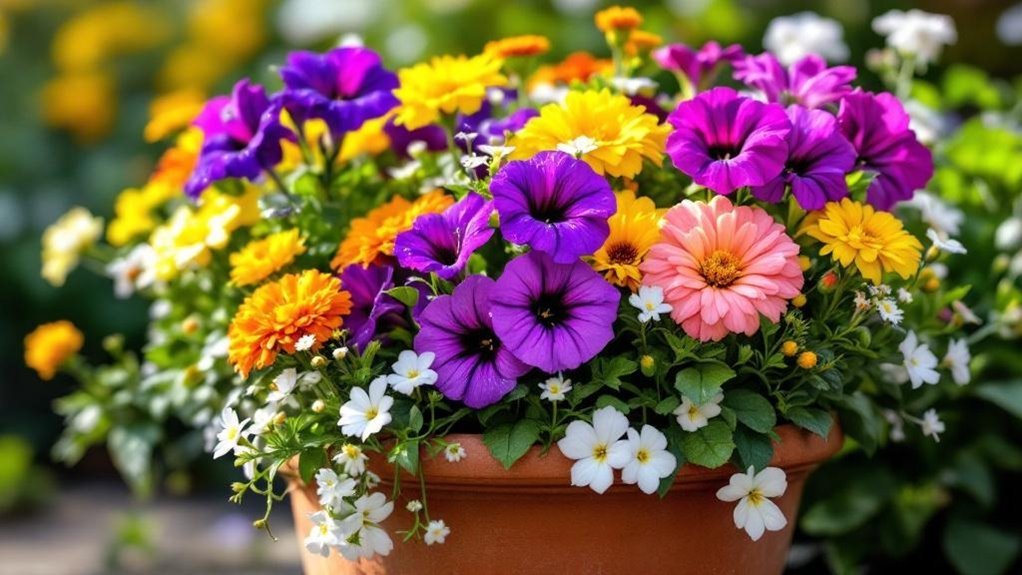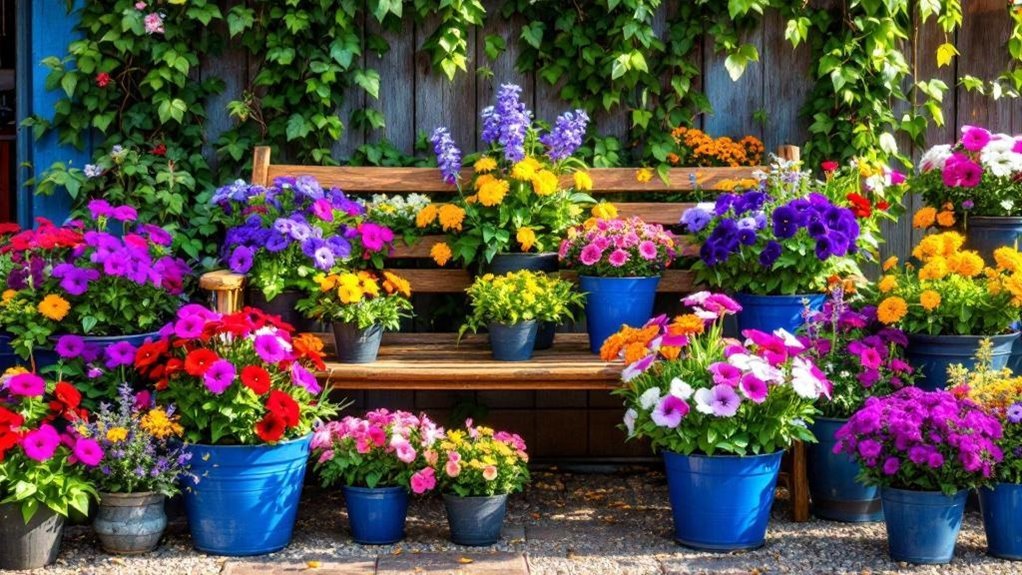You might wonder if container flower gardening is just about picking pretty blooms and planting them. But there’s more to it than meets the eye—combining textures, colors, and foliage can transform simple pots into enchanting displays. When you start considering elements like seasonal plants, balanced designs, and even the container itself, the possibilities expand. So, how do you create arrangements that truly stand out and last through the seasons?
Use Gorgeous Foliage
When you use gorgeous foliage like Acalypha wilkesiana, your container garden instantly becomes more vibrant and eye-catching. Incorporating plants with striking leaves adds depth and contrast that flowering plants alone can’t achieve.
You can mix foliage plants such as coleus or elephant ear with blooms to create bold, dynamic container arrangements. Experiment with textures and colors—deep purples paired with bright greens add drama and enhance your garden’s visual appeal.
Plus, foliage plants provide consistent interest year-round, keeping your containers lively even when flowers aren’t in season. Don’t forget trailing varieties like sweet potato vine, which soften the edges and complement upright plants beautifully.
Create a Summertime Gem
Although summer’s heat can challenge many plants, you can create a stunning container garden by choosing tough varieties like Profusion zinnias that offer vibrant color and long-lasting blooms.
Combine these with seasonal plants like Angelonia Angelface White to add height and elegance to your stunning container.
Add bold foliage with Coleus (Solenostemon Wild Lime) for striking contrast.
Don’t forget to include trailing sweet potato vine (Ipomoea) to soften edges and add lush greenery.
Use a container with good drainage and quality potting mix to support healthy growth.
Water regularly and deadhead spent blooms to keep your beautiful container garden fresh all season. Additionally, consider incorporating organic fertilizers to promote healthy soil and plant growth throughout the summer.
With these steps, you’ll craft a vibrant, resilient summertime gem that thrives despite the heat.
Use a Color Scheme

Selecting a color scheme for your container garden simplifies the design process and makes your arrangement more visually appealing. By focusing on one or two complementary colors, you create a harmonious, beautiful garden that looks intentional and polished. Deep turquoise containers, for example, highlight blue and purple flowers, adding striking contrast.
Consider these plant combinations to achieve a cohesive color scheme in your container gardens:
- Angelonia Angelface Dresden Blue paired with Calibrachoa Superbells Blue
- Celosia Purple Flamingo mixed with blue-hued blooms
- Repeating a limited palette across multiple containers for unity
Using a consistent color scheme helps your plant combination stand out and unifies your garden space, making it a stunning and well-planned display.
Go Classic With Black
Black containers bring a timeless elegance to your flower garden while making vibrant blooms and rich foliage pop.
Using black containers in container gardening creates a striking backdrop that highlights contrasting textures and colors, making your plants stand out vividly.
Incorporate elephants ear (Colocasia) to add height and lushness, complementing the dark container while enhancing the garden’s depth. The rich, deep foliage of Colocasia contrasts beautifully against the sleek black, creating a dramatic effect.
Plus, black containers absorb heat, which can benefit your plants during cooler nights.
This classic approach works well in both contemporary and traditional designs, giving you a versatile and stunning garden feature.
Embrace black containers to elevate your container gardening with timeless style and bold visual impact.
Mix It Up

Anyone can create a vibrant container garden by mixing different plant varieties to break free from traditional color schemes and seasonal expectations.
When you mix it up, you make your garden pop with texture, color, and shape. Use a combination of plants like Sweet potato vine (Ipomoea) for trailing greenery, Creeping Jenny (Lysimachia) for a splash of chartreuse, and a bold focal point like chrysanthemums or flowering cabbage.
This blend adds depth and keeps your container visually exciting.
Try these ideas:
- Combine tall annuals with low-growing Creeping Jenny for contrast.
- Use Sweet potato vine to soften edges with cascading leaves.
- Pick a striking focal point to anchor the arrangement.
Mixing plants creatively lets you craft stunning, unique container gardens that stand out all season.
Employ Foliage for Season-Long Power
When you incorporate a variety of foliage plants into your container garden, you guarantee it stays visually appealing even when flowers fade. Foliage adds texture, color, and depth, ensuring your display remains vibrant throughout the seasons.
Incorporating diverse foliage keeps your container garden vibrant and textured, even after flowers fade.
Include plants like Sweet potato vine for trailing leaves that create movement and softness. Mix in contrasting textures and colors to boost visual interest—think bold, upright leaves paired with delicate, cascading vines.
Foliage plants are generally more resilient, so they maintain your container garden’s lush look despite changing weather. By using foliage-heavy arrangements, you set a rich backdrop that highlights seasonal blooms, making your garden dynamic and layered all year long.
This approach gives you a container garden that’s stunning from spring through fall with minimal effort.
Plant Grasses
Adding one or two varieties of grasses to your container garden instantly boosts height and visual drama. When you plant grass in containers, you add unique texture and movement that enliven any arrangement.
Grasses also serve as a perfect backdrop to flowering plants, balancing your garden’s visual weight. To get the best effect:
- Choose grasses like Purple Fountain Grass for vibrant color and graceful sway
- Use grasses as thrillers to add height and draw attention
- Pair grasses with fillers and spillers to create a dynamic container garden
Make sure to select grasses with growth habits that complement—not overpower—your other plants.
Create Elegance
To create elegance in your container garden, focus on a soft pink color scheme that radiates timeless charm.
Start with delicate begonias and sweet potato vine to add texture and gentle greenery. Incorporate bright pink blooms sparingly to provide subtle pops of color without overpowering the arrangement.
Aim for a spring container filled with at least five complementary plants, combining petal-filled flowers like tree roses with vincas to enhance depth and sophistication.
Choose containers with refined, classic designs that perfectly frame your floral selections, ensuring a cohesive and polished look.
Keep It Balanced
Although achieving balance in container gardening can seem tricky, you can create a harmonious arrangement by carefully choosing plants in proportional quantities.
Use the thriller, filler, and spiller formula to structure your container: the thriller stands tall, the filler adds fullness, and the spiller cascades over edges. For example, use a dramatic purple fountain grass as your thriller, vibrant Blue Nemesia as the filler, and trailing Sweet potato vine or Creeping Jenny as spillers.
Remember to select plants with similar light and water needs to keep your container healthy. Regularly assess and adjust the arrangement to maintain visual harmony as plants grow.
- Thriller: tall centerpiece plants
- Filler: medium-height, bushy plants
- Spiller: trailing plants like Sweet potato vine or Creeping Jenny
Frequently Asked Questions
What Are the Most Beautiful Flowers to Grow in Pots?
You’ll love growing petunias, geraniums, calibrachoas, zinnias, and sweet potato vines in pots. They offer vibrant colors, cascading blooms, and striking foliage, making your container garden burst with beauty all summer long.
How Can I Make My Container Garden Look Good?
You can make your container garden look good by mixing foliage and flowers, choosing complementary colors, and using the thriller, filler, spiller method. Refresh plants seasonally and pick unique containers to add charm and interest.
What Is the Most Common Mistake Made With Container Plants?
You’re like a sailor drowning your plants in a storm when you overwater container plants. The most common mistake is giving them too much water, causing root rot. Let your plants breathe and water wisely!
What Flowers Go Well Together in Pots?
You’ll want to combine petunias, geraniums, and sweet potato vines for vibrant, cascading effects. Pair contrasting colors and textures, like purple foliage with pink-white flowers, and add fillers like violas for balanced, eye-catching pot arrangements.
Final Thoughts
You might think container flower gardening is too tricky or time-consuming, but once you get the hang of mixing gorgeous foliage with seasonal blooms, it becomes a rewarding, creative escape. By choosing a cohesive color scheme, balancing textures and heights, and using timeless black containers, you’ll craft stunning displays that brighten any space year-round. Don’t hesitate—embrace these ideas and watch your container garden thrive beautifully with minimal effort.
